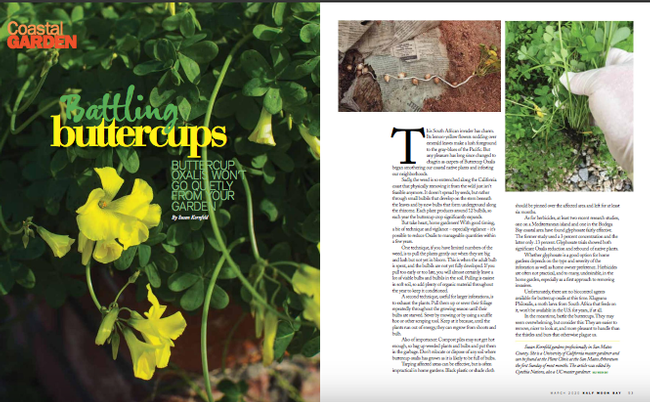This South African invader has charm. Its lemon-yellow flowers nodding over emerald leaves make a lush foreground to the gray-blues of the Pacific. But any pleasure has long since changed to chagrin as carpets of Buttercup Oxalis began smothering our coastal native plants and infesting our neighborhoods.
Sadly, the weed is so entrenched along the California coast that physically removing it from the wild just isn't feasible anymore. It doesn't spread by seeds, but rather through small bulbils that develop on the stem beneath the leaves and by new bulbs that form underground along the rhizome. Each plant produces around twelve bulbils, so each year the buttercup crop significantly expands.
But take heart, home gardeners! With good timing, a bit of technique, and vigilance – especially vigilance – it's possible to reduce Oxalis to manageable quantities within a few years.
One technique, if you have limited numbers of the weed, is to pull the plants gently out when they are big and lush but not yet in bloom. This is when the adult bulb is spent, and the bulbils are not yet fully developed. If you pull too early or too late, you will almost certainly leave a lot of viable bulbs and bulbils in the soil. Pulling is easiest in soft soil, so add plenty of organic material throughout the year to keep it conditioned.
A second technique, useful for larger infestations, is to exhaust the plants. Pull them up or sever their foliage repeatedly throughout the growing season until their bulbs are starved. Sever by mowing or by using a scuffle hoe or other scraping tool. Keep at it because, until the plants run out of energy, they can regrow from shoots and bulb.
Also of importance: Compost piles may not get hot enough, so bag up weeded plants and bulbs and put them in the garbage. Don't relocate or dispose of any soil where buttercup oxalis has grown as it is likely to be full of bulbs.
Tarping affected areas can be effective, but is often impractical in home gardens. Black plastic or shade cloth should be pinned over the affected area and left for at least six months.
As for herbicides, at least two recent research studies, one on a Mediterranean island and one in the Bodega Bay coastal area have found glyphosate fairly effective. The former study used a 3% concentration and the latter only .13%. Glyphosate trials showed both significant Oxalis reduction and rebound of native plants.
Whether or not glyphosate is a good option for home gardens depends on the type and severity of the infestation as well as home owner preference. Herbicides are often not practical, and to many, undesirable, in the home garden, especially as a first approach to removing invasives. Unfortunately, there are no biocontrol agents available for buttercup oxalis at this time. Klugeana Philoxalis, a moth larva from South Africa that feeds on it, won't be available in the U.S. for years, if at all.
In the meantime, battle the buttercups. They may seem overwhelming, but consider this: they are easier to remove, nicer to look at, and more pleasant to handle than the thistles and burs that otherwise plague us.
Susan Kornfeld gardens professionally in San Mateo County. She is a UC Master Gardener and can be found at the Plant Clinic at the San Mateo Arboretum the first Sunday of most months. The article was edited by Cynthia Nations, UC Master Gardener
Attached Images:
